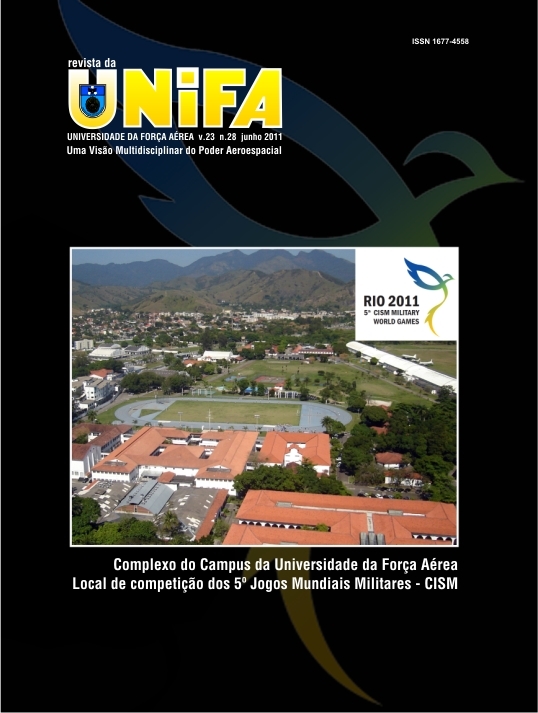Planning vs. Execution:
an analysis of VC-2 missions from the point of fatigue in flight
DOI:
https://doi.org/10.22480/revunifa.2011.23.641Keywords:
Flight fatigue, Air mission planning, PDCA Cycle, Flight safetyAbstract
This article aimed to identify in which way missions of VC-2 had the management of the in flight fatigue affected by not foreseen factors in the planning, during the period from September 2009 to July 2010. The nature of the research presented exploratory characteristics because it showed the problem of managing fatigue in flight missions of VC-2. The used methodology was the documentary research, complemented by data collection through interviews. With the theoretical reference presented, it was possible to establish a relation between the missions of VC-2 and the theory of Case Management, giving emphasis on the PDCA Cycle. It was approched the whole process of planning a mission, as well as the legislation for guiding the management of fatigue in flight. It was extracted flight data of the planned and executed journeys, type of crew and not foreseen factors in the planning, of the 356 missions accomplished in that period. These data were analyzed according to the stipulated in the planning and it was concluded that the management of fatigue in flight was affected in 31 missions, or 9% of the total. Moreover, it was found that the most important factor involved was the boarding delay of passengers and cargo expected in the mission, presented in 9 of them.
References
BRASIL. Comando da Aeronáutica. Centro de Investigação e Prevenção de Acidentes Aeronáuticos. NSCA 3-1: conceituação de vocábulos, expressões e siglas de uso no SIPAER. Brasília, DF, 2009.
BRASIL. Comando da Aeronáutica. Centro de Investigação e Prevenção de Acidentes Aeronáuticos. Resumo dos relatórios finais dos acidentes de 1995 a 1999. Brasília, DF, 2003.
BRASIL. Comando da Aeronáutica. Gabinete do Comandante da Aeronáutica. DGAB 001/GC2/2008: limite de tempo de envolvimento em atividade aérea no Grupo de Transporte Especial – fadiga de voo. Brasília, DF, 2008.
BRASIL. Comando da Aeronáutica. Gabinete do Comandante da Aeronáutica. RICA 21-39: regimento interno do Grupo de Transporte Especial. Brasília, DF, 2007.
CAMPOS, V. F. TQC – Controle da Qualidade Total (no estilo japonês). 8. ed. Nova Lima: INDG Tecnologia e Serviços Ltda, 2004.
DAVIS, J. R. et al. Fundamentals of Aerospace Medicine. 4. ed. Philadelphia: Wolters Kluwer, 2008.
DEMING, W. E. Qualidade: a revolução da administração. São Paulo: Marques Saraiva, 1990.
HAWKINS, F. H. Human factors in flight. 2. ed. Aldershot: Ashgate, 1987.
KANASHIRO, R. G. Fadiga de voo. In: TEMPORAL, W. (Org.). Medicina Aeroespacial. Rio de Janeiro: Luzes, 2005. p. 335-342.
MARANHÃO, M.; MACIEIRA, M. E. B. O processo nosso de cada dia: modelagem de processos de trabalho. Rio de Janeiro: Qualitymark, 2004.
NATIONAL TRANSPORTATION SAFETY BOARD. AAR94-04: Aircraft Accident Report. Washington, 1994.
VELASCO DÍAZ, C. et al. Medicina Aeronáutica: actuaciones y limitaciones humanas. Madri: Paraninfo, 1995.
WHITELEY, R.C. A empresa totalmente voltada para o cliente. Rio de Janeiro: Elsevier, 1992.
Downloads
Published
Issue
Section
License
Copyright (c) 2011 João Gustavo Lage Germano

This work is licensed under a Creative Commons Attribution-NonCommercial 4.0 International License.
Revista da UNIFA permite que o (s) autor (es) mantenha(m) seus direitos autorais sem restrições. Atribuição-NãoComercial 4.0 Internacional (CC BY-NC 4.0) - Revista da UNIFA é regida pela licença CC-BY-NC









